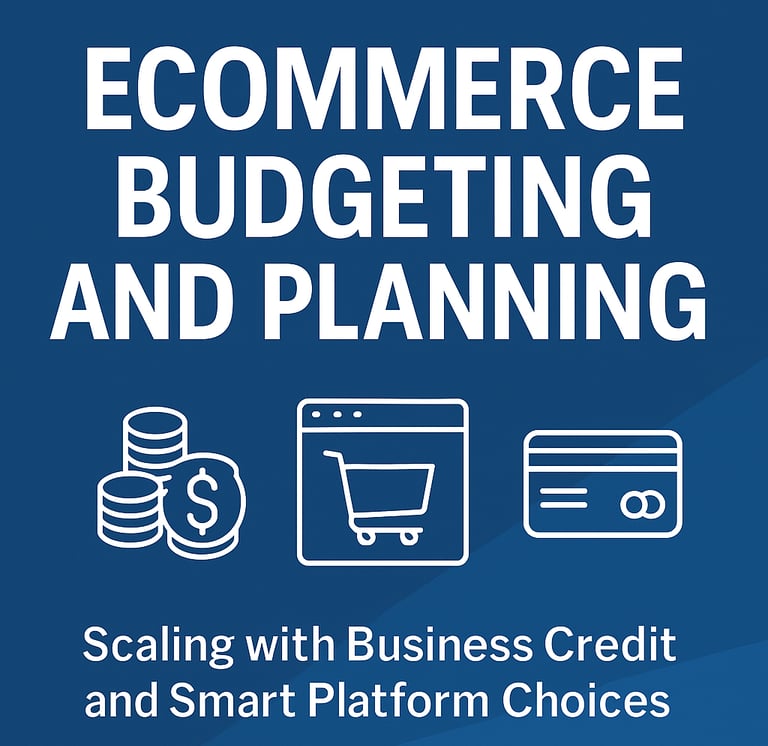Ecommerce Budgeting and Planning: Scaling with Business Credit and Smart Platform Choices
Ecommerce isn’t just about selling products—it’s about having a plan that makes the most of your money. With three business credit cards, each offering $10K to $20K in available credit, you can fuel your growth without burning through your own cash. Let’s break down exactly how to budget, plan, and launch ecommerce success across platforms like Amazon, Walmart, TikTok, and Shopify.



The Power of Business Credit in Ecommerce
Using business credit unlocks scalability. Instead of draining personal savings, you use OPM—other people’s money—to fund inventory, tools, and marketing. This allows you to:
Fund a done for you Walmart automation store or a Shopify store automation service
Invest in business website design packages or affordable web design for service providers
Set up a digital business setup with low risk and high reward
Budget Scenario: 3 Business Credit Cards at $10K–$20K Each
With $30K to $60K available, here’s a smart plan:
Card 1 ($10K): Fund initial inventory for Amazon or Walmart. Focus on high-turnover, low-risk products.
Card 2 ($20K): Cover web development and ecommerce business setup service USA for Shopify or TikTok. This includes site fees and setup tools.
Card 3 ($10K): Cover affordable Google Ads management for small business, SEO, and other marketing essentials to drive traffic.
Platform Costs and Expectations
Amazon: Pro Seller account at $39.99/month. FBA fees, storage, and returns can add up. Works best for electronics, books, and household items.
Walmart: Account approval and setup fees are common. Inventory costs are a must. Great for groceries, household goods, and essentials.
Shopify: Starts at $39/month. Add-ons for landing page design for coaches or custom themes can increase costs. Flexible for niche products with low competition.
TikTok Shop: Low entry cost but requires significant ad spend. Better for trendy, fast-moving consumer goods and viral products.
High vs Low Competition Products
High-competition products like electronics or branded fashion are risky for newcomers. They often require heavy Google Ads setup for e-commerce stores and high marketing spend.
Low-competition products—niche handmade items, unique designs, or custom solutions—allow for organic traffic and lower ad costs. Digital marketing for new businesses with unique offerings can create a competitive edge.
Best Product Types by Platform
Amazon: Electronics, books, gadgets, household essentials
Walmart: Food items, household goods, low-ticket everyday products
Shopify: Niche fashion, digital downloads, subscription boxes, unique brand stories
TikTok Shop: Viral products, accessories, beauty items, gadgets
Growth Infrastructure with Business Credit
Leverage business credit for high ROI spending, like inventory and web development.
Use business credit consulting services or personal credit repair for entrepreneurs to build stronger credit and unlock bigger lines.
Invest in automated systems and plug-and-play marketing for efficiency.
SEO and Marketing for Ecommerce Success
Set up affordable Google Ads management for small business to drive traffic.
Use local SEO services for startups to boost Shopify or TikTok sales.
SEO expert for credit repair companies can help position your site for long-term growth.
Invest in future-ready business tools for zero-to-launch agency setups.
Ecommerce success doesn’t happen by chance. With a clear plan, three business credit cards, and the right platform strategy, you can launch your brand, get more qualified leads, and create scalable ecommerce solutions. Whether it’s Amazon, Walmart, Shopify, or TikTok, the key is budgeting, leveraging business credit, and staying disciplined with your growth plan.



